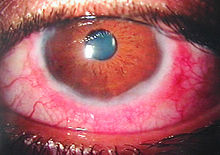Medical condition
| Vernal keratoconjunctivitis |
|---|
| Other names | Spring catarrh; Vernal catarrh; Warm weather conjunctivitis |
|---|
 |
| Some of the cornea and conjunctiva findings in vernal conjunctivitis |
| Specialty | Ophthalmology |
|---|
Vernal keratoconjunctivitis (VKC, also Spring catarrh, Vernal catarrh or Warm weather conjunctivitis) is a recurrent, bilateral, and self-limiting type of conjunctivitis (pink eye) having a periodic seasonal incidence.
Vernal keratopathy
Corneal involvement in VKC may be primary or secondary due to extension of limbal lesions. Vernal keratopathy includes 5 types of lesions.[citation needed]
- Punctuate epithelial keratitis.
- Ulcerative vernal keratitis (shield ulceration).
- Vernal corneal plaques.
- Subepithelial scarring.
- Pseudogerontoxon.
Cause
VKC is thought to be an allergic disorder in which IgE mediated mechanism play a role. Such patients often give family history of other atopic diseases such as hay fever, asthma or eczema, and their peripheral blood shows eosinophilia and increased serum IgE levels.
Diagnosis
Classification
Based on severity, authors have classified VKC into clinical grades:[3]
Grade 0 - Absence of symptoms
Grade 1 MILD - Symptoms but no corneal involvement
Grade 2 MODERATE - Symptoms with photophobia but no corneal involvement
Grade 3 SEVERE - Symptoms, photophobia, mild to moderate SPK's OR with Diffuse SPK or corneal ulcer
